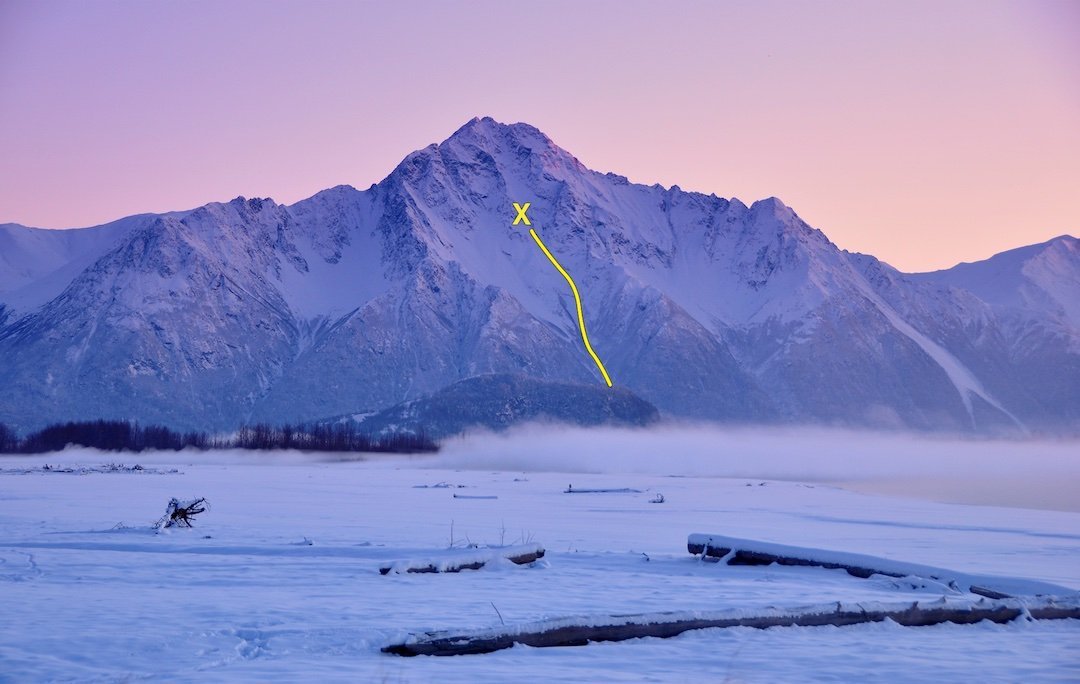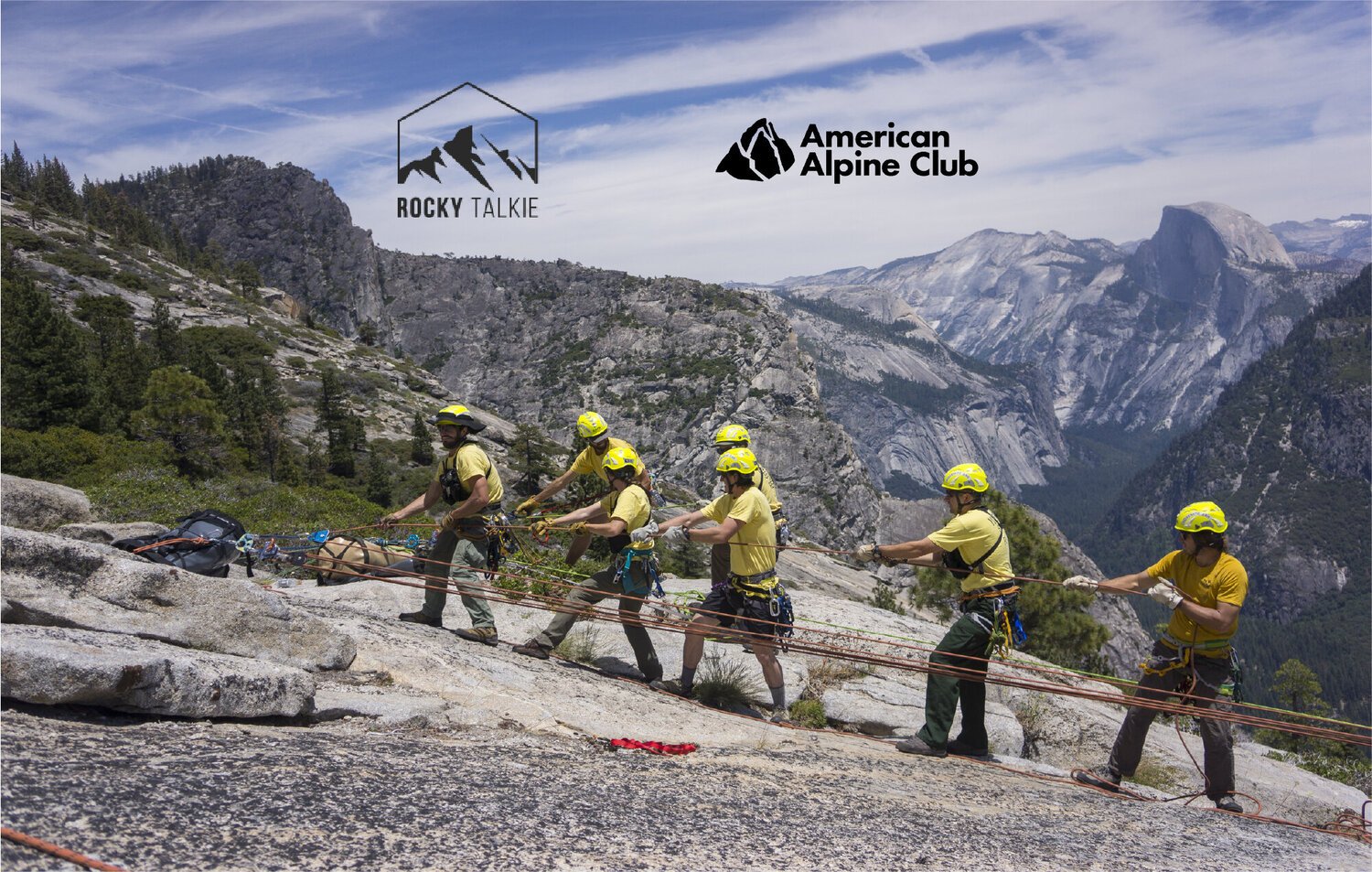The north face of Pioneer Peak, showing the route attempted in the incident below. X marks approximate site of the anchor where the climbers were impacted by avalanches. Photo by Cecil Sanders
The Prescription - December 2021
Alaska, Chugach Mountains, Pioneer Peak
Two Avalanches – Rope Cut, Anchor Unclipped
We know that many people don’t read every single report in Accidents—particularly ones that are far from home and more than three pages long. But we want to call your attention to the story highlighted here, both for the lessons it imparts and for the drama of the events—fortunately they ended without a fatality or very serious injuries. A condensed outline follows. We highly recommend reading the full report, starting on page 20 of this year’s book or at this page on our publications website.
On April 15, Fallon Connolly, 26, and Simon Frez-Albrecht, age 28 (both experienced climbers), started up the nearly 6,000-foot north face of Pioneer Peak, northeast of Anchorage, at 5:45 a.m. It had been 37°F at the car. Near the second ice band on the long snow and ice route, about 4,000 feet above the start, Fallon observed signs of what appeared to be fairly recent avalanches on the gully walls. Simon was about 50 feet ahead of Fallon and had nearly reached a position to anchor for the next pitch when he noticed a very small wet loose avalanche come tumbling over the ice above. He yelled down to warn Fallon. Simon was standing to one side of the gully, and it didn’t hit him, but it all washed directly over Fallon; she planted both tools firmly and put her head down to let the snow pass. They estimated the flow lasted 60 seconds.
After the flow stopped, Fallon continued up to where Simon was waiting and they moved together perhaps 50 feet up and to the opposite side of the gully, where there were some obvious cracks in the rock. Here they built an anchor and, given what they had observed, prepared to descend from this point. Simon bounce-tested their bail anchor and then set up their brand-new 7.8mm ropes (pink and green) and threaded them through his device for a rappel. Fallon also pre-rigged her device on the rappel ropes. A number 2 Camalot they had placed temporarily was clipped to the ropes as backup, with a non-locker on a 60cm sling. Fallon remained clipped to the cord masterpoint in the anchor with a locking carabiner as Simon began to rappel. When Simon was about halfway down, Fallon yelled to warn him about another avalanche coming over the ice pitch above.
What followed was an extraordinary “series of unfortunate events”:
Brand-new rope cut during this incident.
• Fallon was knocked off her feet by the slide and left hanging from her tether clipped to the anchor. Her gloves and glasses disappeared.
• Their pink rappel rope broke (likely cut against a sharp edge of rock), but the knot joining the ropes jammed in Fallon’s pre-rigged rappel device, keeping the other rope attached to her and thus to the anchor.
• Simon was pummeled by avalanche debris for one to three minutes. Only a tangle in the green rope kept him from being pulled to the end of the rope by the debris.
• As the slide ended, Fallon stood up at the anchor. Before she could reinforce her tether or anchor the green rope, a second avalanche rumbled over the ice above. This time, Fallon was pulled from the anchor and tumbled down the slope.
Damage to Fallon’s harness when she was hit by avalanches at the rappel stance on Pioneer Peak. The harness likely would have sustained many kilonewtons of force to be damaged this way, yet both it and the anchor held.
• Simon heard and saw the second slide coming and was able to shelter behind a rock outcrop, yet the debris plucked him from this stance and he fell another 100 feet down the snow gully. Fallon slid and tumbled a total of 300 to 400 feet.
Very fortunately, neither climber was buried, swept all the way down the mountain, or seriously injured, and they were able to self-rescue to the road.
In his analysis of the incident, Simon outlined numerous important but subtle clues they missed when they decided to climb this route on a relatively warm day. “We felt we had pieced together enough information to make an informed decision,” he wrote. “I suspected the shed cycle had already happened in the previous warm, sunny days, so there wouldn’t be a significant amount of loose/available snow left on the mountain to slide onto us. I didn’t consider that the freezing at night had been enough to keep the snow locked in place, poised above us.
“Probably the single most obvious clue we missed,” he continued, “was that it had stayed cloudy the night before our climb, preventing the radiant cooling that had dropped night time temps in the previous days. This kept the snowpack wet and near the tipping point when the weak sun struck the face for a couple of hours through the clouds.”
Ten days after the accident, in colder conditions, Simon climbed back to their anchor to try to determine what had happened. He found a sharp edge where the pink rope, oscillating under load during the slide, likely had cut. However, most of the anchor was intact. Fallon’s tether and locking carabiner, which had fallen with her during the second avalanche, also were undamaged. “Why had she come unclipped from the anchor?” Simon wondered. “The only conclusion we can draw is that the screw-gate locker with which Fallon clipped her tether to the master point must have jiggled to the unlocked position during the first avalanche. Then, when she unweighted the tether, the locker must have shifted into a position where it could unclip itself when the second avalanche pushed her back onto her tether.”
A mock setup of pre-rigged rappel devices, where two climbers have set up both of their rappel devices before the first starts down. (Anchor tethers and backups are omitted for clarity.) Click the photo to find a good article exploring the pros and cons of pre-rigging rappels. Photo courtesy of AlpineSavvy.com
Simon might have slid all the way down the mountain during the first avalanche, when the pink rope broke, except for one extra step the two took while preparing to rappel. “Over the last year or two, I have been making a conscious effort to increase my safety margin while climbing,” Simon wrote. “This includes tying knots in the ends of ropes during rappels, using a rappel backup, and using autolocking carabiners and assisted braking belay devices more often. I had recently been toying with pre-rigging rappel devices as well, but was not doing this consistently. For whatever reason, this was one of those times we pre-rigged Fallon’s belay device on the rope, and by snagging the knot joining the ropes after our pink rope cut, it happened to keep me alive.”
Again, we encourage you to read the full report in ANAC 2021 or find it here. We’re grateful to climbers like Simon and Fallon who choose to share such stories, which can be painful or even embarrassing to recount. They teach us that the little things sometimes can make all the difference.
VIA FERRATA LANYARDS RECALLED
In mid-November, Petzl announced a recall of Scorpio Eashook via ferrata lanyards, sold either individually or as part of a via ferrata kit (lanyard, harness, helmet), because of possible malfunctions in the lanyard’s carabiners. The recall affects lanyards with certain serial numbers and manufactured since January 1, 2021; customers who purchased these lanyards are urged to stop using them immediately. See Petzl’s website for details and compensation information.
ROCKFALL AND RESCUE IN ZION NATIONAL PARK
Aaron, 42, and Ian, 16 are a father-son team of adventurous climbers from Tucson, Arizona. In June 2021, with lots of exploratory climbing experience under their belts, they headed to Zion National Park to attempt a relatively obscure route on a cliff informally known as Mt. Greer. On the 12th pitch, gunning for the top of the formation, Aaron was leading a gully and chimney system when the rock under his feet crumbled, sending sandstone blocks tumbling down the gully toward his son. Listen to the new Sharp End podcast to hear all about how they got into this predicament—and how they got out.
The monthly Prescription newsletter is supported by adidas Outdoor and the members of the American Alpine Club. Questions? Suggestions? Write to us at [email protected].











